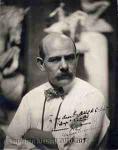Gutzon Borglum
Gutzon Borglum
Mjesto: St. Charles
Rođen: 1867
Smrt: 1941
Biografija:
John Gutzon de la Mothe Borglum was an American artist and sculptor. He is most associated with his creation of the Mount Rushmore National Memorial in Keystone, South Dakota. He was associated with other public works of art, including a bust of Abraham Lincoln exhibited in the White House by Theodore Roosevelt and now held in the United States Capitol Crypt in Washington, D.C..
The son of Danish immigrants, Gutzon Borglum was born in 1867 in St. Charles in what was then Idaho Territory. Borglum was a child of Mormon polygamy. His father, Jens Møller Haugaard Børglum (1839–1909), had two wives when he lived in Idaho: Gutzon's mother, Christina Mikkelsen Borglum (1847–1871) and Gutzon's mother's sister Ida, who was Jens's first wife. Jens Borglum decided to leave Mormonism and moved to Omaha, Nebraska where polygamy was both illegal and taboo. Jens Borglum worked mainly as a woodcarver before leaving Idaho to attend the Saint Louis Homeopathic Medical College in Saint Louis, Missouri. At that point "Jens and Christina divorced, the family left the Mormon church, and Jens, Ida, their children, and Christina's two sons, Gutzon and Solon, moved to St. Louis, where Jens earned a medical degree. (Jens) then moved the family to Nebraska, where he became a county doctor". Upon his graduation from the Missouri Medical College in 1874, Dr. Borglum moved the family to Fremont, Nebraska, where he established a medical practice. Gutzon Borglum remained in Fremont until 1882, when his father enrolled him in St. Mary's College, Kansas.
After a brief stint at Saint Mary's College, Gutzon Borglum relocated to Omaha, Nebraska, where he apprenticed in a machine shop and graduated from Creighton Preparatory School.
Elizabeth Janes was born in Racine, WI on December 21, 1848. She studied art and music in Boston, New York, and Paris. Her marriage to J. W. Putnam ended in divorce. She taught music in Milwaulkee before moving to San Francisco in 1881, studying art at the School of Design under Virgil Williams and L. P. Latimer, moving to Los Angeles, California in 1884 and the next year began art study with William Keith. In 1885, she met Gutzon Borglum, who was also a student of Keith's. In 1889 in Los Angeles she married Borglum who was her pupil and 19 years younger. The Borglums spent the next ten years traveling widely, studying and exhibiting in Europe. Borglum was trained in Paris at the Académie Julian, where he came to know Auguste Rodin and was influenced by Rodin's impressionistic light-catching surfaces. Borglum's works were accepted to the 1891 and the 1892 Paris Salons. In Paris, Elizabeth studied with Felix Hildago. Elizabeth took part in the 1892 Columbus Centennial Exhibition in Spain. A return trip to California proved to be ill-timed, as the state was in the throes of a financial depression. In 1893, they purchased a home, "El Rosario", in Sierra Madre, California. In 1896 Gutzon and Elizabeth went back to Europe, this time to London. In London, she studied with California painter Emil Carlsen. Due to marital problems she returned to southern California in 1902, while Borglum was living in England. After she and Borglum separated in 1903 and divorced in 1908, Elizabeth stayed at "El Rosario". She continued her art career, painting and teaching and taking classes from J. Foxcroft Cole. In 1915, she moved to Venice, California, dying there on May 21, 1922. Elizabeth Borglum's work is rooted in the Tonalist-Barbizon esthetic.
Back in the U.S. in New York City he sculpted saints and apostles for the new Cathedral of Saint John the Divine in 1901; in 1906 he had a group sculpture accepted by the Metropolitan Museum of Art — the first sculpture by a living American the museum had ever purchased—and made his presence further felt with some portraits. He also won the Logan Medal of the Arts. His reputation soon surpassed that of his younger brother, Solon Borglum, already an established sculptor.
Borglum married Mary Montgomery Williams, on May 20, 1909, with whom he had three children, including a son, Lincoln, and a daughter, Mary Ellis (Mel) Borglum Vhay (1916–2002).
In 1925, the sculptor moved to Texas to work on the monument to trail drivers commissioned by the Trail Drivers Association. He completed the model in 1925, but due to lack of funds it was not cast until 1940, and then was only a fourth its originally planned size. It stands in front of the Texas Pioneer and Trail Drivers Memorial Hall next to the Witte Museum in San Antonio. Borglum lived at the historic Menger Hotel, which in the 1920s was the residence of a number of artists. He subsequently planned the redevelopment of the Corpus Christi waterfront; the plan failed, although a model for a statue of Christ intended for it was later modified by his son and erected on a mountaintop in South Dakota. While living and working in Texas, Borglum took an interest in local beautification. He promoted change and modernity, although he was berated by academicians.
More...
Wikipedia link: Click Here



